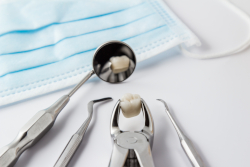Dental Unit Waterlines, Biofilm, and Water Quality
Studies show dental unit waterlines (narrow-bore plastic tubing that carries water to the high-speed handpiece, air/water syringe, and ultrasonic scaler) can become colonized with microorganisms, including bacteria, fungi, and protozoa. These microorganisms colonize and replicate on the interior surfaces of the waterline tubing and form a biofilm, which serves as a reservoir. The reservoir can increase the number of free-floating (i.e., planktonic) microorganisms in water used for dental treatment.
Safe Dental Waterlines Protocol
Extracted Teeth Disposal
Extracted teeth that are being discarded are subject to the labeling provisions of the OSHA Bloodborne Pathogen Standard. OSHA considers extracted teeth to be potentially infectious material (OPIM) that should be placed into medical waste containers. Extracted teeth containing amalgam should not be placed in a medical waste container that uses an incinerator for final disposal. State and local regulations should be consulted regarding disposal of amalgam.
Many metal recycling companies will accept extracted teeth with amalgam. Contact a recycler and ask about their policies and any specific handling instructions they may have. Extracted teeth may be returned to the patients upon request and are not subject to the provisions of the OSHA Bloodborne Pathogens Standard.
Knowledge Check Choose the best answer for the question.
2-6. OSHA considers all extracted teeth to be potentially infectious material (OPIM) that should be _____.
You forgot to answer the question!

